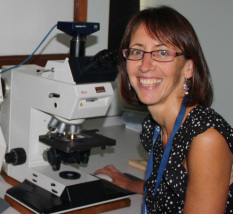|
Name: Qualifications:
Position: E-mail: Phone: |
Address:
Liverpool Ocular Oncology Research Group
Eye and Vision Sciences
Institute of Life Course & Medical Science
3rd Floor, William Henry Duncan Building
6 West Derby Street
Liverpool
L7 8TX
Link to Dr Helen Kalirai Publications
Research Interests:
Dr Helen Kalirai is a senior postdoctoral research fellow with a strong background in biobanking (custodian of the Liverpool Ocular Oncology Biobank) and molecular pathology (Manager of the Liverpool Ocular Oncology Molecular Pathology Service). Dr Kalirai is also developing several areas of research within LOORG:
- The developmental origin of uveal melanocytes from cells of the neural crest suggests that primitive multipotent remnants of these cells may be present in the uveal tract and/or that neural crest developmental signalling pathways have been harnessed by the uveal melanoma cells permitting metastatic spread and colonisation. By understanding more about choroidal melanoblast biology and migration we may gain novel insight into the aberrant processes that occur during uveal melanoma development and metastasis.
- The average survival of patients with metastatic UM (mUM) is approximately 12 months, and there are currently no proven effective treatments. The reasons for the refractory behaviour of UM cells to current therapies remain unclear; however, our previous data examining the secretome of primary UM indicated the upregulation of extracellular matrix (ECM) proteins; collagens, fibronectin and laminin, and glycoproteins; aggrecan and thrombospondin, in UM at high risk (HR) of developing metastatic disease. Bioinformatic analysis of the secretome data also identified hepatic fibrosis as one of the most differentially upregulated biological processes in HR-UM, suggesting that this is required during tumour progression. By understanding the composition of the ECM in UM and how this may differ between aggressive and more indolent tumours as well as at the primary and metastatic sites, we can use this information to develop novel 3D culture models for drug testing that more accurately reproduce the in vivo setting.


